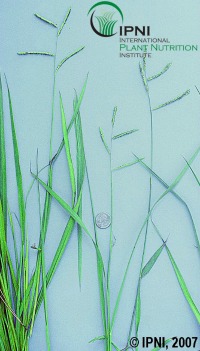Dallisgrass
 Dallisgrass is a fast growing perennial used primarily for pasture. See Establishment Guidelines for Grasses for seeding details. Yields of dallisgrass are similar to Argentine or common bahiagrass. It has smooth leaves, a deep root system and grows in clumps of few to many stems. Numerous leaves occur at the base of the plant, but few leaves are found on the stems. The slender stems tend to droop when seedheads develop.
Dallisgrass is a fast growing perennial used primarily for pasture. See Establishment Guidelines for Grasses for seeding details. Yields of dallisgrass are similar to Argentine or common bahiagrass. It has smooth leaves, a deep root system and grows in clumps of few to many stems. Numerous leaves occur at the base of the plant, but few leaves are found on the stems. The slender stems tend to droop when seedheads develop.
Dallisgrass is adapted to low, moist areas and also produces well on fertile uplands. Though dallisgrass is not recommended for new plantings, it is a common species in pastures and can be managed for forage production. A legume, such as one of the recommended white clovers, can be grown with this grass to improve forage production and quality.
Another management concern is dallisgrass’s susceptibility to an ergot infection of the seedheads. Livestock that consume dallisgrass infected with ergot can develop dallisgrass staggers (dallisgrass poisoning). Dallisgrass staggers is common in pastures that contain large amounts of dallisgrass.
Animals afflicted by dallisgrass staggers have uncontrolled twitching, make sudden movements, are easily spooked, and will often run when startled. In many cases, the animals will become so spooked that they will attempt to run through or jump fences or panels and may hurt themselves or persons that happen to be in the wrong place at the wrong time. Death from dallisgrass staggers is rare but it can cause death indirectly (e.g., drowning in a pond, falling off of a steep slope, etc.). In the most severe cases, however, the animals will go down, convulse, and even die. The only treatment is to remove the animals from the affected areas and provide them with an alternative forage/feed source. Usually, if the toxins are removed from the diet and the animals are safely confined, recovery from the poisoning can be complete.
Dr. Dennis Hancock
Forage Extension Specialist
Crop & Soil Sciences Dept.
